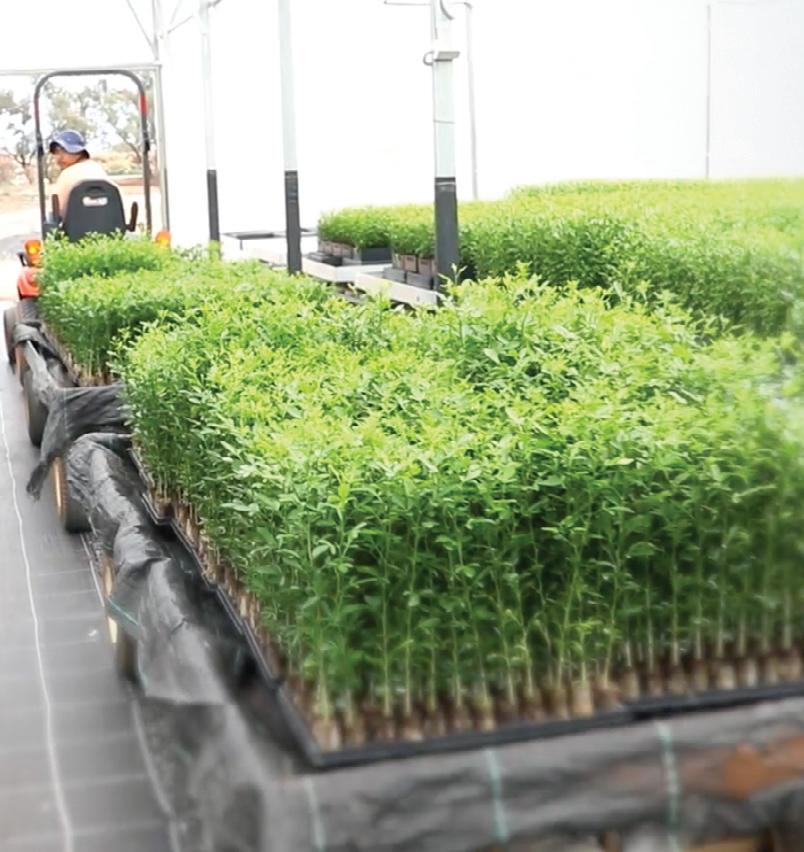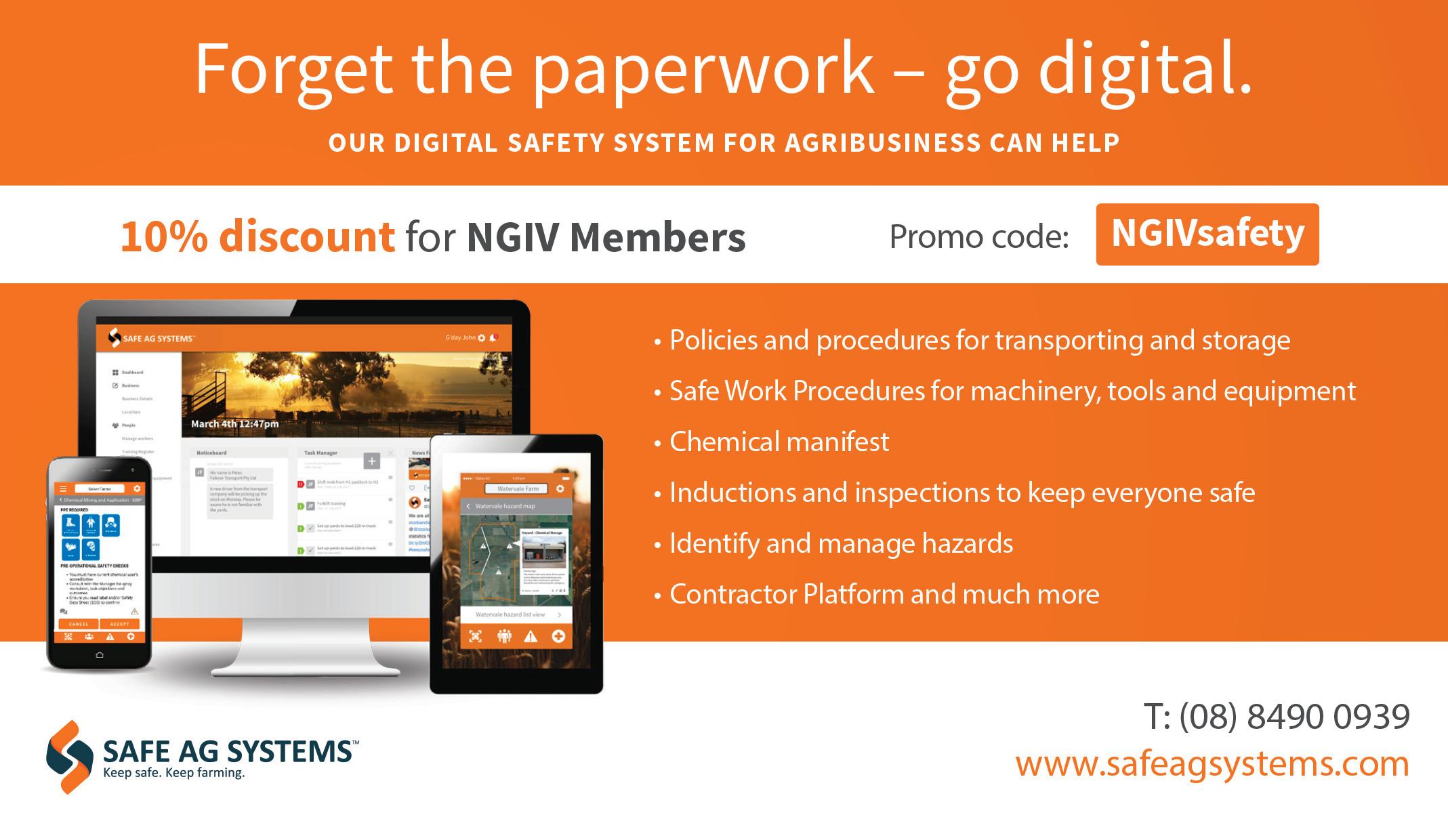
6 minute read
THE TOP 5 HAZARDS IN HORTICULTURE
Did you know that the highest contributing occupation for serious claims in agriculture are workers in farm, forestry, and garden? Workers in these fields equate to 49 per cent or an average of 1,350 claims per year according to Safe Work Australia’s Priority Industry Snapshot (Agriculture 2018). From this snapshot, we know the main cause of injuries in the horticulture sector are from muscular stress and falls on the same level.
Like all sub-industries that make up the agricultural industry, plant nurseries come with their own health and safety challenges. Whilst the list below may not be unique, they are the most common hazards in horticulture.
Manual Handling
In Horticulture, specifically plant nursery workers, the number one injury causing hazard is manual handling. Most day to day tasks will require some form of manual handling which can lead to a range of sprains and strains.
Manual handling can generally be split into two groups, those that have an immediate impact and include high force movements such as pushing and pulling trolleys, loading and unloading bulky items as well as lifting, carrying and restraining loads. The second group consists of low impact, but repetitive movement such as potting or pruning. Repetitive movement can cause damage involving overextending or attempting to move heavy items can cause gradual wear and tear on your body down. Being static for long periods of time can have a negative impact on your posture.
Hazardous Substances
Use of chemicals in horticulture is common. When you fail to handle, store, and dispose of hazardous chemicals appropriately, you are risking illness and sometimes even death. This exposure to hazardous chemicals is often a preventable situation in plant nurseries and most horticultural workplaces. Do you know what is classified as a hazardous chemical or substance? Generally, it is any material or mixture that can put a person at risk, this can include insecticides, herbicides, fuels, and cleaners. Exposure to these hazards can come in the form of vapours, liquids, and gases that can be corrosive and toxic.
As part of your hazardous chemical administrative process, you should ensure anyone using chemicals has received training in their safe use, and also maintain a digital Chemical Manifest for tracking. Safe Ag Systems provides a simple solution included in its software. Maintain your chemical manifest in a digital system that can be accessed anywhere. Don’t risk losing your paper Safety Data Sheets, save them and link to the digital copy. A chemical inventory will allow you to access a list as well as usage, location of use and weather conditions when spraying, etc.
When maintaining your chemical manifest, you must include a copy or link to the relevant manufacturers current Safety Data Sheet (SDS). The SDS must provide information on the hazardous chemical including ingredients, health and emergency response procedures, safe handling as well as transportation, storage and disposal.
When there is no other option and chemical exposure is essential, you must provide adequate personal protection equipment for your workers. Safety Data Sheets will guide you on appropriate equipment.

UV Exposure
To be able to function at optimum levels, your body needs to maintain a temperature of 37 degrees Celsius. Exposure to UV as well as heat, is one of the hazards in horticulture that needs addressing.

When you think of heat-related illnesses your mind will picture heat stroke and exhaustion, fainting, heat rash or cramps, but are you aware heat can impact your ability to concentrate and it also affects how your body absorbs chemicals.
No matter whether your workers are indoors or outdoors, heat can cause severe health and safety issues. However, when working outdoors ultra-violet radiation (UVR) is a real threat that should be managed. In NSW alone, between 2006/07 – 2016/17, workers compensation claims relating to skin cancer amounted to cost of over $12.5 million (Safe Work NSW, working in extreme heat). Damage caused by UVR is permanent, but there are a number of preventions and protective methods that can be utilised. It is recommended that when outdoors, workers should wear sun safe PPE made of suitable material. This includes a broadbrimmed or legionnaires hat, wrap-around sunglasses, long sleeved shirts with collars, trousers and at least SPF 30+, broad-spectrum sunscreen. As part of your sun safe commitment consider incorporating SunSmart’s resource tools such as the free SunSmart app or sunscreen calculator.
Machinery & Equipment
As we always mention, workers have the right to go home safe each day. With the aim to make your workplace safer and work easier, you may use plant, machinery, and equipment to assist with tasks. This could include forklifts, mobile/powered nursery benches, pot handlers, trailers and power tools.
Whilst these mechanical aids assist in the reduction of manual handling and increase efficiency, they do present their own risks and hazards. Your workers need to be trained in the correct use of each piece of machinery and equipment.
Forklifts are often used for numerous tasks including lifting, stacking and transportation. When operated incorrectly it can result in serious injury and even death through workers being hit or crushed, which is why only licenced operators should use a forklift. There is also a real risk of a forklift tip-over if overloaded or unstable. Identifying safety controls needs to be part of your S.A.F.E. process to manage risks. Plant machinery and equipment should have correct machine guarding over moving parts or areas where a person could be injured –incorporate this as part of safety controls.

Incorporating machinery and equipment in your day to day operations presents itself with a hidden hazard, noise. As an employer (PCBU) it is your responsibility to ensure minimise the exposure to noise and where this is not possible, to provide and ensure all workers utilise personal hearing protection such as earmuffs or earplugs. Whilst it may not present itself straight away, years of exposure to noise levels above 85 decibels can result in permanent hearing loss.

Biological Hazards
According to SA Health, Legionella Longbeachae, a bacteria that can cause pneumonia, is one of the real risks and a biological hazard in gardening. Biological hazards can be present when handling potting mix, compost, fertilisers and soil. However, it is not just when handling these items. These mixtures can also cause irritation, allergic reactions and respiratory problems as dust and loose particles become airborne and inhaled.
To provide adequate protection, your workers need to be supplied with gloves and a disposable, industrial dust mask. Consider implementing best practices such as wetting down soil before use and thoroughly washing your hands after coming in to contact with possible contaminants (Victorian Government, Education and Training, Horticulture Module).
Although these are just some of the injury causing hazards, they are not the only ones faced by horticulture and plant nursery workers. The risk of slips, trips and falls can be managed with simple housekeeping measures, such as keeping your walkways clear of obstructions such as tools, cabling or loose mats, ensuring wet or greasy spills are cleaned up promptly and making sure your workers are wearing adequate footwear for their working conditions. Even just reminding people to watch where they are walking, especially if they are carrying objects which could obstruct their view can help.
Where is the industry going?
In 2014 nursery, flowers and cultivated turf reported a gross value production of $1,247 million and thanks to high standards across the supply chain, the Australian Horticultural industry has developed a reputation as a sustainable producer of premium safe food (Department of Agriculture, Horticulture fact sheet).
With health and safety as a priority, 2020 and 2021 are set to bring challenging disruptions. Seasonal labour shortages are a reality due to COVID-19 travel restrictions, meaning experienced overseas workers that usually contribute will be in short supply.









